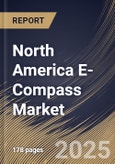The US market dominated the North America E-Compass Market by country in 2024, and is expected to continue to be a dominant market till 2032; thereby, achieving a market value of $606.2 million by 2032. The Canada market is experiencing a CAGR of 11.8% during 2025-2032. Additionally, the Mexico market is expected to exhibit a CAGR of 10.8% during 2025-2032. The US and Canada led the North America E-Compass Market by Country with a market share of 69.9% and 12% in 2024.
MEMS miniaturization, software-defined sensor fusion, and developer-friendly APIs have all helped the North American e-compass market grow from standalone magnetometers to fully integrated orientation subsystems. Fused heading outputs that combine magnetometers, accelerometers, and gyroscopes are now used in consumer electronics, wearables, vehicles, drones, and industrial systems. These outputs make sure that orientation is always correct, even when the device is tilted. Major suppliers like Honeywell and PNI make strong modules that are factory-calibrated and have self-test, anomaly detection, and low-noise designs. This lowers the risk of integration for applications in the automotive, aerospace, and robotics fields. Regulatory and infrastructure projects, such as the U.S. DOT ITS programs and the FAA small-UAS frameworks, have made the need for resilient heading in GNSS-denied environments even more clear. This has made the e-compass a key backup to IMUs and satellite navigation.
Market trends point to deep sensor fusion, hardening based on mobility, and very low-power, small solutions for edge devices. Advanced firmware now handles anomaly detection, calibration, and graceful recovery, turning heading into a software-enhanced service instead of just a raw sensor readout. Leaders use silicon-plus-software stacks, reference designs, and developer resources to speed up integration while keeping lifecycle support, environmental robustness, and EMC resilience. There is competition at the component, module, and platform levels. More and more, differences are based on the quality of the software, the experience of the developers, and how well the software works in real-world situations. In North America, the market is dynamic but well-organized. Incumbents with proven fusion stacks and documented reliability are in charge, while niche players take care of specific use cases in wearables, UAVs that don't use GNSS, and high-EMI mobility environments.
Technology Outlook
Based on Technology, the market is segmented into Hall-Effect, AMR / GMR / TMR, Fluxgate, Magneto-Inductive, and Quantum (NV-center, Optically-pumped). The Hall-Effect market segment dominated the US E-Compass Market by Technology is expected to grow at a CAGR of 7.5 % during the forecast period thereby continuing its dominance until 2032. Also, The Quantum (NV-center, Optically-pumped) market is anticipated to grow as a CAGR of 12.6 % during the forecast period during 2025-2032.Form Factor Outlook
Based on Form Factor, the market is segmented into Integrated Sensor-Combo (Accel + Mag), SoC-embedded e-Compass, Discrete Compass Modules, and Dev-Boards & Custom ASICs. Among various Canada E-Compass Market by Form Factor; The Integrated Sensor-Combo (Accel + Mag) market achieved a market size of USD $22.4 Million in 2024 and is expected to grow at a CAGR of 11.1 % during the forecast period. The Dev-Boards & Custom ASICs market is predicted to experience a CAGR of 13.9% throughout the forecast period from (2025 - 2032).Country Outlook
There is an abundance of demand for e-compasses in the U.S. because of consumer electronics, automotive ADAS and autonomous systems, drones, robotics, and IoT/AR applications. This is supported by a strong domestic ecosystem for semiconductor design, MEMS development, and system integration. Some of the most important things that affect growth are the push for self-driving navigation, high consumer expectations for accurate and low-power orientation sensors, and the need for reliable performance in environments where magnetic interference is common, such as in robotics, UAVs, and AR/VR applications. Market trends are focused on sensor fusion, making sensors smaller, making them more power-efficient, and using software to improve calibration for better accuracy, stability, and robustness in the real world. U.S. OEMs have integrated global MEMS and sensor players into their businesses. Differentiation isList of Key Companies Profiled
- STMicroelectronics N.V.
- Asahi Kasei Corporation
- Robert Bosch GmbH
- Honeywell International, Inc.
- NXP Semiconductors N.V.
- TDK Corporation
- Infineon Technologies AG
- MEMSIC Semiconductor Co., Ltd. (IDG Capital Investment Consultant Beijing Co Ltd.)
- Allegro Microsystems, Inc. (Sanken Electric Co., Ltd.)
- Garmin Ltd.
Market Report Segmentation
By Axis Orientation
- 3-Axis
- 6- & 9-Axis Sensor Fusion
- 1-2-Axis
By Technology
- Hall-Effect
- AMR / GMR / TMR
- Fluxgate
- Magneto-Inductive
- Quantum (NV-center, Optically-pumped)
By Form Factor
- Integrated Sensor-Combo (Accel + Mag)
- SoC-embedded e-Compass
- Discrete Compass Modules
- Dev-Boards & Custom ASICs
By Application
- Consumer Electronics
- Automotive (Navigation, ADAS)
- Aerospace & Defense
- Industrial & Robotics
- Marine & Sub-sea
- Healthcare & Wearables
- Others
By Country
- US
- Canada
- Mexico
- Rest of North America
Table of Contents
Companies Mentioned
- STMicroelectronics N.V.
- Asahi Kasei Corporation
- Robert Bosch GmbH
- Honeywell International, Inc.
- NXP Semiconductors N.V.
- TDK Corporation
- Infineon Technologies AG
- MEMSIC Semiconductor Co., Ltd. (IDG Capital Investment Consultant Beijing Co Ltd.)
- Allegro Microsystems, Inc. (Sanken Electric Co., Ltd.)
- Garmin Ltd.








